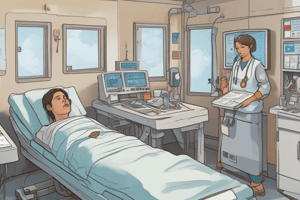Podcast
Questions and Answers
What is the primary reason why children are at a higher risk of inhaling toxic airborne substances during disasters?
What is the primary reason why children are at a higher risk of inhaling toxic airborne substances during disasters?
- Their lower metabolic rate
- Their smaller lung capacity
- Their greater minute ventilation (correct)
- Their slower respiratory rate
Why may infants require early oxygen administration following exposure to noxious chemicals?
Why may infants require early oxygen administration following exposure to noxious chemicals?
- Because they have a higher oxygen consumption rate (correct)
- Because they have a lower oxygen consumption rate
- Because they have a slower heart rate
- Because they have a larger lung capacity
What is a nonspecific sign of respiratory distress observed in pediatrics exposed to toxic gases?
What is a nonspecific sign of respiratory distress observed in pediatrics exposed to toxic gases?
- Bradypnea
- Tachypnea (correct)
- Dyspnea
- Tachycardia
What is the implication of cartilaginous and compliant chest walls in infants and young children?
What is the implication of cartilaginous and compliant chest walls in infants and young children?
What is the result of increased work of breathing in children with respiratory distress?
What is the result of increased work of breathing in children with respiratory distress?
What is the estimated blood volume in children per kilogram?
What is the estimated blood volume in children per kilogram?
What is the consequence of small amount of blood loss from trauma in children?
What is the consequence of small amount of blood loss from trauma in children?
Why do children have greater cardiac reserves than adults?
Why do children have greater cardiac reserves than adults?
What is the result when children's cardiac reserves fail to compensate for fluid losses?
What is the result when children's cardiac reserves fail to compensate for fluid losses?
What is the significance of children's greater minute ventilation in disaster response?
What is the significance of children's greater minute ventilation in disaster response?
Flashcards are hidden until you start studying




